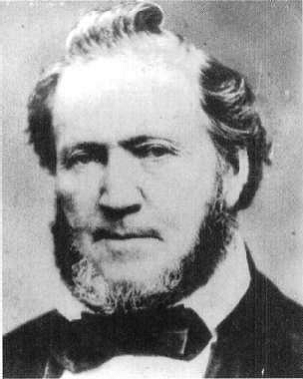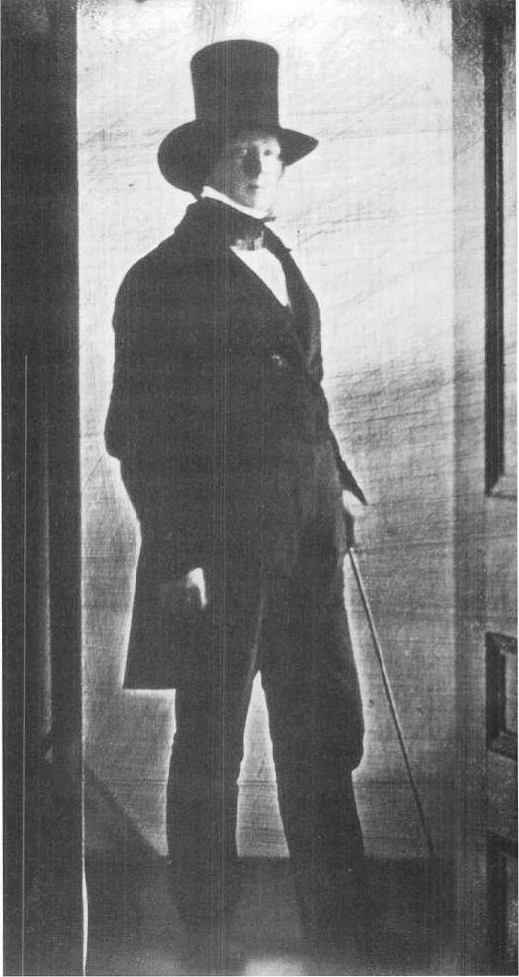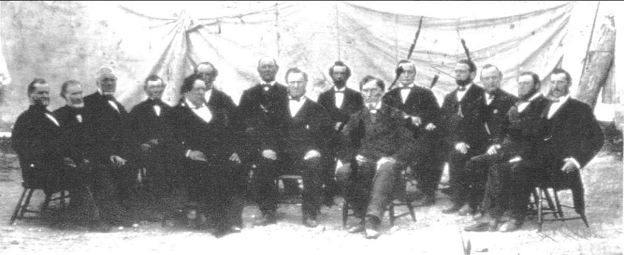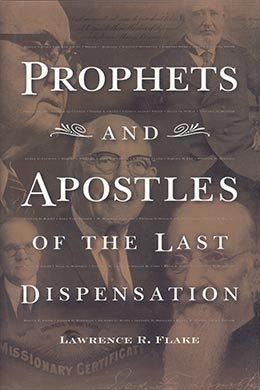Brigham Young
Lawrence R. Flake, Prophets and Apostles of the Last Dispensation (Provo, UT: Religious Studies Center, Brigham Young University, 2001), 23–33.

Born: 1 June 1801, Whitingham, Vermont
Quorum of the Twelve Apostles: 14 February 1835 (age 33)
President of the Quorum of the Twelve: 14 April 1840
President of the Church: 27 December 1847 (age 46)
Died: 29 August 1877 (age 76), Salt Lake City, Utah
The wagon bound for Kirtland, Ohio, moved much too slowly for Brigham Young on that September afternoon in 1832. At the end of this dusty road he would have the greatest of the many remarkable experiences that had filled his five months as a Latter-day Saint. Today he would meet the Prophet, Joseph Smith.
Several anxious hours later Brigham stood gazing at a handsome, muscular man almost five years his junior, engaged in chopping firewood. “Here my joy was full at the privilege of shaking the hand of the Prophet of God, and [I] received the sure testimony, by the Spirit of prophecy, that he was all that any man could believe him to be, as a true Prophet.” [1] This was the beginning of a lifelong love of profound depth that Brigham Young had for the Prophet Joseph Smith. He once exclaimed, “I feel like shouting hallelujah, all the time, when I think that I ever knew Joseph Smith, the Prophet.” [2] At a meeting later that day Brigham arose and spoke in tongues; it was the first time the brethren present had heard the true gift of tongues. [3] Afterward Joseph made a remarkable prophecy: “The time will come when brother Brigham Young will preside over this Church.” [4]
The cruel assassination of the beloved Prophet years later was a heavy blow to Brigham Young. Though the third apostle in seniority when the Twelve were ordained 14 February 1835, the apostasy of Thomas B. Marsh and the death of David W. Patten made him the senior member of the Quorum of the Twelve and rightful successor to the presidency of the Church. There was confusion in the minds of some as to who should govern the Church at the death of the Prophet Joseph, but not in the mind of Brigham. “Joseph conferred upon our heads all the keys and powers belonging to the Apostleship which he himself held before he was taken away, and no man or set of men can get between Joseph and the Twelve in this world or in the world to come.” [5] Another time he recalled, “While at Brother Bement’s house in Peterboro’ [New Hampshire], I heard a letter read which brother Livingston had received from Mr. Joseph Powers, of Nauvoo, giving particulars of the murder of Joseph and Hyrum. The first thing which I thought of was, whether Joseph had taken the keys of the kingdom with him from the earth; brother Orson Pratt sat on my left; we were both leaning back on our chairs. Bringing my hand down on my knee, I said the keys of the kingdom are right here with the Church.” [6]
Upon receiving word of the Prophet’s death, Brigham Young and the other apostles who were in the East returned to Nauvoo where they found Sidney Rigdon attempting to take over the leadership of the Church. In a public meeting on 8 August 1844, Elder Rigdon sought to be recognized as the guardian of the Church. After he had presented his case, Brigham Young explained with great clarity how the Lord through the Prophet Joseph Smith had given the authority to preside over the Church to the Twelve. During this powerful discourse the
 President Brigham Young, ca. 1846
President Brigham Young, ca. 1846
Lord gave a miraculous manifestation, which confirmed the fact that Brigham Young was to lead the Church. [7] One of the hundreds who witnessed this transfiguration was George Q. Cannon, a seventeen-year-old boy who would later serve as a counselor to Brigham Young and to three other presidents of the Church: “President Brigham Young . . . arose and addressed the people. . . . If Joseph had risen from the dead and again spoken in their hearing, the effect could not have been more startling than it was to many present at that meeting. It was the voice of Joseph himself; and not only was it the voice of Joseph which was heard; but it seemed in the eyes of the people as though it was the very person Joseph which stood before them.” [8] After leading the Church as president of the Twelve for three and a half years, Brigham Young was sustained president of the Church, and the First Presidency was reorganized.
Brigham Young, who had overseen the exodus of twelve thousand Saints from their mob-ridden settlements in Missouri, was a natural leader. Born of pious, poverty-stricken parents, he learned early the lessons of hard work. [9] His father, John Young of Whitingham, Windham County, Vermont, was a strict disciplinarian. Brigham related: “I was brought up so strict, so firm in the faith of the Christian religion by my parents, that if I had said ‘Devil” I believed I had sworn very wickedly.” [10] When Brigham was three years old, the Young family moved to New York, where at age sixteen he abandoned farming, the occupation of his youth, to become a glazier and carpenter. In 1824 he married Miriam Works. In the years that followed, he became very interested in religion, examining and inquiring after the beliefs of the various churches in the surrounding area. He found all of them to be disappointing and unsatisfying. [11] When he and Miriam moved in 1829 to Mendon, New York, just a few miles from Palmyra, he began to hear deprecatory rumors about the young Joseph Smith. [12] He read a newspaper article concerning the “Indian Bible” that an angel had purportedly given the young man. Brigham’s brother, Phineas Young, received a copy of the Book of Mormon from Samuel Smith, the first missionary in this dispensation. Brigham described his reaction to it: “I weighed the matter for a year and a half. I looked at it on all sides. . . . I reasoned on month after month, until I came to a certain knowledge of its truth.” [13]
Brigham finally received a strong witness to the validity of the new religion when some Latter-day Saint missionaries from Columbia, Pennsylvania, about 120 miles away, came to Mendon to preach the gospel. Even before his baptism in 1832, Brigham journeyed to Canada to share his conviction of the restored Church with his brother Joseph. [14] In September of the year he joined the Church, his wife Miriam died, leaving him with two little daughters, ages eight and two. Placing the little girls in the care of his wife’s dear friend, Vilate Kimball, he traveled to Kirtland where Joseph Smith made the prophecy of Brigham’s future greatness. Within the first few years of his Church membership, he traveled to Canada to preach his new-found religion, moved to Kirtland where he married Mary Ann Angel, made the trek with the Prophet to Missouri as a participant in Zion’s Camp, became a member of the first Quorum of the Twelve of this dispensation, and moved his growing family to Missouri to share the trials of the Saints there.
His willingness to endure hardships for the Church emerged early. Four years after becoming an apostle, he departed for a mission to England. His family was in dire need of his care. He said, “I left my wife sick, with a babe only ten days old, and all my children sick and unable to wait upon each other.” [15] He arrived in England penniless, but the mission was a phenomenal success. “Through the mercy of God we have gained many friends, . . . baptized between seven and eight thousand, . . . and emigrated to Zion 1,000 souls.” [16]
In 1847 Brigham led the pioneer company of 143 men, three women, and two children to the Salt Lake Valley, which he recognized from having seen a vision as the future home of the Saints. Wilford Woodruff left this record of their arrival in the valley: “President Young expressed his entire satisfaction at the appearance of the valley as a resting place for the Saints and felt amply repaid for his journey. While lying upon his bed, in my carriage, gazing upon the scene before us, many things of the future, concerning the valley, were shown to him in vision.” [17]
 First Presidency and Quorum of the Twelve Apostles, October 1868. Left to right: Orson Hyde, Orson Pratt, John Taylor, Wilford Woodruff, George A. Smith, Ezra T. Benson, Charles C. Rich, President Brigham Young, Lorenzo Snow, Daniel H. Wells, Erastus Snow, Franklin D. Richards, George Q. Cannon, Brigham Young Jr., and Joseph F. Smith
First Presidency and Quorum of the Twelve Apostles, October 1868. Left to right: Orson Hyde, Orson Pratt, John Taylor, Wilford Woodruff, George A. Smith, Ezra T. Benson, Charles C. Rich, President Brigham Young, Lorenzo Snow, Daniel H. Wells, Erastus Snow, Franklin D. Richards, George Q. Cannon, Brigham Young Jr., and Joseph F. Smith
A modern-day Moses, he led his people to their promised land and became, in the estimate of many, the country’s greatest colonizer. He directed the establishment of nearly four hundred communities. The historian Herbert E. Bolton wrote: “Brigham Young was a devout believer, but more especially he was a lion-hearted man of iron will, an organizer, and the founder of a commonwealth. Few if any other examples in Anglo-American history can be found of a man who so thoroughly dominated a great colonization movement as Brigham Young. . . . Certainly none of [the other American colony builders] had a harder struggle with nature and with neighbors.” [18] He offered the tremendous force needed to accomplish the almost insurmountable task of gathering over a hundred thousand Saints to the Rocky Mountains, many of them so poverty stricken they would never have been allowed to join most westward-bound expeditions. Especially ingenious was his plan for bringing Latter-day Saint immigrants from the east by sending wagons from Salt Lake City back to transport them out to the valley. These “down and back trips” saved purchasing hundreds of horses, oxen, and wagons that would otherwise have been needed, and which the immigrants would not have been able to afford. [19]
The prophet-governor could not abide people who felt that he should not give counsel in daily affairs. “Take the people and I am proud of them; but there is a feeling with them that they must not be counseled in their temporal matters. I call this a sectarian notion, for we will find yet that God is Dictator in everything.” [20] President Young taught the people industry and thrift: “A great many men do not know that they can keep a pig; but there is not a family in this city . . . but what can save enough from their table, from the waste made by the children, and what must be swept in the fire and out of door, to make pork sufficient to last them through the year, or at least all they should eat.” [21]
On the other hand, he was a great believer in recreation and enjoyment in life. He encouraged theater, music, picnics, dancing, and other forms of wholesome entertainment. He said, “The mind of a man who is wholly devoted to the Church and kingdom of God on the earth is powerfully exercised. . . . What do they need? A little relaxation.” [22] Another time he expressed his approval of music: “Tight-laced religious professors of the present generation have a horror at the sound of a fiddle. There is no music in hell, for all good music belongs to heaven.” [23] Regarding parties, he said, “Is there any harm in Sunday School parties? No! it is one of the most harmless kinds of enjoyment when conducted aright. If they wish to dance, let them dance; let them talk and play; but not do any wrong.” [24] He also encouraged education and even the possession of fine material goods, especially if they could be manufactured at home.
In spite of the love and skill with which he governed the Saints, he was the subject of constant abuse, for many outsiders accused him of usurping power, of tyrannizing his people, of seeking to maintain a governorship illegally, and of gratifying his own physical desires in the practice of plural marriage. He valiantly protected the Saints from the onslaught of many persecutions, including the threatened invasion of the United States Army upon the valley in 1857 to impose a new governor on the territory. At this time he became a bold denouncer of the evils that designing men tried to inflict on the Church: “This people are free; they are not in bondage to any government on God’s footstool. We have transgressed no law, and we have no occasion to do so, neither do we intend to; but as for any nation’s coming to destroy this people, God Almighty being my helper, they cannot come here.” [25] But even more than being determined that their valley home would not be desecrated, he was determined to follow the Lord’s will—even in this matter of war. He said, “I am willing to fight, or to go; to run, or to stay; or to do anything else that the Lord Almighty requires of me for His Kingdom’s sake, and then to lay down my life for His cause.” [26] Arriving at an agreement with Brigham Young, the U.S. Army peaceably entered the valley. President James Buchanan’s non-Mormon appointee, Albert Cummings, replaced Brigham Young as governor of the territory. Though stripped of his secular authority, his office as president of the Church assured his continuing leadership of the people until his death in 1877. He said, “Whether [I remain] as Governor of Utah Territory or not; and, whether I should be President of the United States, or King of Great Britain, or Monarch of all the world, my religion and my God are first and foremost with me. My kingship, my presidentship, and all shall bow to that eternal Priesthood which God has bestowed upon me.” [27]
During his years of Church leadership, Brigham Young’s accomplishments were too numerous to list, but a few of the most significant were these: colonizing the Utah Territory, establishing and popularizing the theater in Salt Lake City; organizing a retrenchment society for young women (forerunner of the YWMIA); dealing as mercifully as possible with the American Indians; founding numerous educational institutions; facilitating the passage of laws giving women the right to vote; supporting the coming of the railroad and telegraph to Utah; fostering many large enterprises such as cotton and woolen mills, sugar beet factories, and iron foundries; working toward statehood for Utah; setting up the Endowment House; and overseeing the construction of four beautiful and enduring temples for the Latter-day Saints. [28]
As this prophet, president, colonizer, statesman, economist, and father of fifty-six children lay dying on his bed barely able to breathe, he suddenly sat up, momentarily renewed with a surge of inexplicable energy, and with eyes that looked intently at a fixed spot, pronounced the name of the man whose lamp he had carried those thirty years: “Joseph! Joseph! Joseph!” His spirit quickly departed this life, undoubtedly in joyful reunion with the beloved Prophet who had come to accompany him home.
Notes
[1] “History of Brigham Young,” Millennial Star, 11 July 1863, 439.
[2] Journal of Discourses, 3:51.
[3] Francis M. Gibbons, Brigham Young: Modern Moses, Prophet of God (Salt Lake City: Deseret Book, 1981), 28.
[4] “History of Brigham Young,” Millennial Star, 11 July 1863,439.
[5] History of the Church, 7:230.
[6] “History of Brigham Young,” Millennial Star, 4 June 1864,359.
[7] Lynne Watkins Jorgensen and BYU Studies Staff, “The Mantle of the Prophet Joseph Passes to Brother Brigham: A Collective Spiritual Witness,” BYU Studies 36, no. 4 (1996–97): 125–204.
[8] “Biography: Joseph Smith, the Prophet,” Juvenile Instructor, 29 October 1870, 174–75.
[9] Preston Nibley, Brigham Young: The Man and His Work (Salt Lake City: Deseret Book, 1965).
[10] Journal of Discourses, 6:290.
[11] Ronald K. Esplin, “Conversion and Transformation: Brigham Young’s New York Roots,” Susan Easton Black and Larry C. Porter, ed., Lion of the Lord: Essays on the Life and Service of Brigham Young (Salt Lake City: Deseret Book, 1995), 26.
[12] Esplin, “Conversion and Transformation,” 31.
[13] “A Family Meeting in Nauvoo: Minutes of a Meeting of the Richards and Young Families held in Nauvoo, Ill., Jan. 8 1845,” Utah Genealogical and Historical Magazine, July 1920,110.
[14] Gibbons, Brigham Young, 18.
[15] “History of Brigham Young,” Millennial Star, 10 October 1863, 646.
[16]“History of Brigham Young,” Millennial Star, 2 January 1864, 7. See James B. Allen, Ronald K. Esplin, and David J. Whittaker, Men With a Mission: The Quorum of the Twelve Apostles in the British Isles, 1837–1841 (Salt Lake City: Deseret Book, 1992).
[17] Edward H. Andersen, The Life of Brigham Young (Salt Lake City: Geo. Q. Cannon & Sons, 1893), 83.
[18] Herbert E. Bolton, “The Mormons on the Opening of the Great West,” Utah Genealogical and Historical Magazine, January 1926, 54.
[19] Leonard J. Arrington, Brigham Young: American Moses (Urbana, IL: University of Illinois Press, 1985), 283.
[20] Journal of Discourses, 12:242.
[21] Journal of Discourses, 4:314–15.
[22] Journal of Discourses, 6:147.
[23] Journal of Discourses, 9:244.
[24] Journal of Discourses, 12:239.
[25] Journal of Discourses, 5:226.
[26] Journal of Discourses, 2:187.
[27] Journal of Discourses, 2:188.
[28] Leonard J. Arrington, “Brigham Young,” Leonard J. Arrington, ed., Presidents of the Church (Salt Lake City: Deseret Book, 1986), 62–72.
